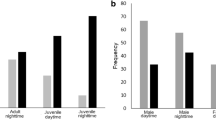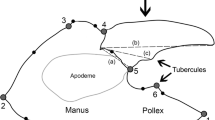Abstract
Male stag beetles battle for females with their impressive, oversized mandibles. We describe their fighting behavior, which is essential to understand the evolution and morphology of their weaponry. Our behavioral analysis reveals several anatomical structures that are important for fighting, and our morphological investigations show how these may be adapted for their functions. Stag beetle fights are much more variable than other armed beetles’ battles. They spend considerable time and effort in dislodging their opponent, that clings to the substrate with its tarsal claws. These tarsal claws are also indispensable to maintain balance in the most spectacular battles, when they lift a rival high in the air. The male claws are highly curved and have an increased height for this purpose. The prothoracic muscles are hypertrophied to support the lifting movement. The largest beetle wins in 85 % of the fights and the smaller the difference in mandible length is between the rivals, the longer the battles can last. The long mandibles enable males to reach the opponent’s legs in order to dislodge it. For this purpose, they bite with all parts of their mandibles, even though the distal part is more vulnerable for failure and transfers less bite force. Blindfolded experiments prove that visual information is not a requisite for a successful battle.











Similar content being viewed by others
References
Araya K (1993) Relationship between the decay types of dead wood and occurrence of lucanid beetles (Coleoptera: Lucanidae). Appl Entomol Zool 28:27–33
Arnott G, Elwood RW (2009) Assessment of fighting ability in animal contests. Anim Behav 77:991–1004. doi:10.1016/j.anbehav.2009.02.010
Bridge AP, Elwood RW, Dick JTA (2000) Imperfect assessment and limited information preclude optimal strategies in male – male ghts in the orb-weaving spider Metellina mengei. Proc R Soc B 267:273–279
Caro TM, Graham CM, Stoner CJ, Flores MM (2003) Correlates of horn and antler shape in bovids and cervids. Behav Ecol Sociobiol 55:32–41. doi:10.1007/s00265-003-0672-6
Crandell KE, Herrel A, Sasa M et al (2014) Stick or grip? Co-evolution of adhesive toepads and claws in Anolis lizards. Zoology. doi:10.1016/j.zool.2014.05.001
Dai Z, Gorb SN, Schwarz U (2002) Roughness-dependent friction force of the tarsal claw system in the beetle Pachnoda marginata (Coleoptera, Scarabaeidae). J Exp Biol 205:2479–2488
Eberhard WG (1977) Fighting behavior of male Golofa porteri beetles. Psyche (Stuttg) 84:292–298
Emlen DJ (2008) The evolution of animal weapons. Annu Rev Ecol Evol Syst 39:387–413. doi:10.1146/annurev.ecolsys.39.110707.173502
Emlen DJ, Marangelo J, Ball B, Cunningham CW (2005) Diversity in the weapons of sexual selection: horn evolution in the beetle genus Onthophagus (Coleoptera: Scarabaeidae). Evolution (N Y) 59:1060–1084. doi:10.1554/04-642
Gotoh H, Fukaya K, Miura T (2012) Heritability of male mandible length in the stag beetle Cyclommatus metallifer. Entomol Sci 15:430–433. doi:10.1111/j.1479-8298.2012.00527.x
Goyens J, Dirckx J, Dierick M et al (2014a) Biomechanical determinants of bite force dimorphism in Cyclommatus metallifer stag beetles. J Exp Biol 217:1065–1071. doi:10.1242/jeb.091744
Goyens J, Soons J, Aerts P, Dirckx J (2014b) Finite Element modelling reveals force modulation of jaw adductors in stag beetles. J R Soc Interface 11:20140908. doi:10.1098/rsif.2014.0908
Goyens J, Dirckx J, Aerts P (2015a) Costly sexual dimorphism in Cyclommatus metallifer stag beetles. Funct Ecol 29:35–43. doi:10.1111/1365-2435.12294
Goyens J, Dirckx J, Aerts P (2015b) Mechanoreceptor distribution in stag beetle jaws corresponds to the material stress in fights. Arthropod Struct Dev (In Press)
Harvey DJ, Gange AC (2006) Size variation and mating success in the stag beetle Lucanus cervus. Physiol Entomol 31:218–226
Hedrick TL (2008) Software techniques for two- and three-dimensional kinematic measurements of biological and biomimetic systems. Bioinspir Biomim 3:034001. doi:10.1088/1748-3182/3/3/034001
Hoem SA, Melis C, Linnell JDC, Andersen R (2006) Fighting behaviour in territorial male roe deer Capreolus capreolus: the effects of antler size and residence. Eur J Wildl Res 53:1–8. doi:10.1007/s10344-006-0053-3
Hongo Y (2003) Appraising behaviour during male-male interaction in the japanese horned beetle Trypoxylus dichotomus septentrionalis. Behaviour 140:501–517
Hongo Y, Okamoto K (2013) Interspecific contests between males of two Japanese stag beetle species, Lucanus maculifemoratus and Prosopocoilus inclinatus: what overcomes a body size disadvantage? Behaviour 150:39–59. doi:10.1163/1568539X-00003036
Iguchi Y (2001) Differences in the frequency of fights between minor and major males in the horned beetle trypoxylus dichotomus septentrionalis (Coleoptera : Scarabaeidae). Entomol Rev Jpn 56:11–14
Inoue A, Hasegawa E (2012) Effect of morph types, body size and prior residence on food-site holding by males of the male-dimorphic stag beetle Prosopocoilus inclinatus (Coleoptera: Lucanidae). J Ethol 31:55–60. doi:10.1007/s10164-012-0350-0
Kawano K (2000) Genera and allometry in the stag beetle family Lucanidae, Coleoptera. Ann Entomol Soc Am 93:198–207. doi:10.1603/0013-8746(2000)093
Kawano K (2006) Sexual dimorphism and the making of oversized male characters in beetles (Coleoptera). Ann Biomed Eng 99:327–341. doi:10.1603/0013-8746(2006)099
Knell RJ, Pomfret JC, Tomkins JL (2004) The limits of elaboration: curved allometries reveal the constraints on mandible size in stag beetles. Proc Biol Sci 271:523–528. doi:10.1098/rspb.2003.2641
Kuan C-Y (2011) To win “big”: determining factors and sequential analyses in male-male combats of a stag beetle, Cyclommatus mniszechi (Coleoptera: Lucanidae) 49
Lagarde F, Corbin J, Goujon C, Poisbleau M (2005) Polymorphisme et performances au combat chez les mâles de Lucane cerf-volant (Lucanus cervus). La Rev d’écol (Terre vie) 60:127–137
McCullough EL, Tobalske BW (2013) Elaborate horns in a giant rhinoceros beetle incur negligible aerodynamic costs. Proc R Soc B 280:20130197. doi:10.1098/rspb.2013.0197
McCullough EL, Zinna RA (2013) Sensilla density corresponds to the regions of the horn most frequently used during combat in the giant rhinoceros beetle trypoxylus dichotomus (Coleoptera: Scarabaeidae: Dynastinae). Ann Entomol Soc Am 106:518–523
Moczek A, Emlen D (2000) Male horn dimorphism in the scarab beetle, Onthophagus taurus: do alternative reproductive tactics favour alternative phenotypes? Anim Behav 59:459–466. doi:10.1006/anbe.1999.1342
Okada Y, Hasegawa E (2005) Size-dependent precopulatory behavior as mate-securing tactic in the Japanese stag beetle, Prosopocoilus inclinatus (Coleoptera; Lucanidae). J Ethol 23:99–102. doi:10.1007/s10164-004-0134-2
Okada K, Miyatake T (2006) Ownership-dependent mating tactics of minor males of the beetle Librodor japonicus (Nitidulidae) with intra-sexual dimorphism of mandibles. J Ethol 25:255–261. doi:10.1007/s10164-006-0021-0
Rink M, Sinsch U (2007) Radio-telemetric monitoring of dispersing stag beetles: implications for conservation. J Zool 272:235–243. doi:10.1111/j.1469-7998.2006.00282.x
Shiokawa T, Iwahashi O (2000a) Mating success of small sized males of Japanese stag beetle Prosopocoilus dissimilis okinawanus nomura. Jpn J Entomol 3:157–165
Shiokawa T, Iwahashi O (2000b) Mandible dimorphism in males of a stag beetle, Prosopocoilus dissimilis okinawanus (Coleoptera: Lucanidae). Appl Entomol Zool 35:87–494. doi:10.1303/aez.2000.487
Siva-Jothy M (1987) Mate securing tactics and the cost of fighting in the Japanese horned beetle, Allomyrina dichotoma L. (Scarabaeidae). J Ethol 5:165–172. doi:10.1007/BF02349949
Suzuki T (1996) Some ecological notes of Cyclommatus metallifer metallifer in Sulawesi, Indonesia - Adult feeding habits and possibility of guarding behavior on stag beetles. Gekkan-Mushi 305:16–19
Tatsuta H, Mizota K, Akimoto S (2001) Allometric patterns of heads and Genitalia in the stag beetle Lucanus maculifemoratus (Coleoptera: Lucanidae). Ann Entomol Soc Am 94:462–466. doi:10.1603/0013-8746(2001)094[0462:APOHAG]2.0.CO;2
Tatsuta H, MIizota K, Akimoto S (2004) Relationship between size and shape in the sexually dimorphic beetle Prosopocoilus inclinatus (Coleoptera: Lucanidae). Biol J Linn Soc 81:219–233. doi:10.1111/j.1095-8312.2003.00279.x
Tulli MJ, Cruz FB, Herrel A et al (2009) The interplay between claw morphology and microhabitat use in neotropical iguanian lizards. Zoology (Jena) 112:379–392. doi:10.1016/j.zool.2009.02.001
Tulli MJ, Abdala V, Cruz FB (2011) Relationships among morphology, clinging performance and habitat use in Liolaemini lizards. J Evol Biol 00024:843–855. doi:10.1111/j.1420-9101.2010.02218.x
Zani PA (2000) The comparative evolution of lizard claw and toe morphology and clinging performance. J Evol Biol 13:316–325. doi:10.1046/j.1420-9101.2000.00166.x
Acknowledgments
The present study was funded by a BOF grand [ID BOF UA 2011-445-a] of the Research Council of University of Antwerp. The SkyScan 1172 high resolution micro CT scanner, located at the VUB facilities, was funded by the Hercules Foundation [grant UABR/11/004]. We thank two anonymous referees for their constructive remarks.
Conflict of interest
The authors declare no competing financial interests.
Author information
Authors and Affiliations
Corresponding author
Electronic supplementary material
Below is the link to the electronic supplementary material.
Online Resource 1
(GIF 16815 kb)
Online Resource 2
(MPG 41010 kb)
Online Resource 3
(MPG 6182 kb)
Online Resource 4
(MPG 15834 kb)
Online Resource 5
(MPG 17032 kb)
Rights and permissions
About this article
Cite this article
Goyens, J., Dirckx, J. & Aerts, P. Stag Beetle Battle Behavior and its Associated Anatomical Adaptations. J Insect Behav 28, 227–244 (2015). https://doi.org/10.1007/s10905-015-9495-3
Revised:
Accepted:
Published:
Issue Date:
DOI: https://doi.org/10.1007/s10905-015-9495-3




